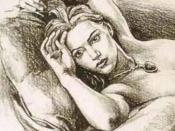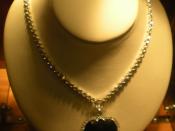The Oscar-winning film Titanic proved to be one of the most profitable films ever made. In this essay I aim to look at the way representation is used within the film and what effect it has on the audience. This will involve looking at different characters and how their class and nationality is represented. My initial opinion is that the film contains bias towards the Americans. Therefore, I am also going to explore the ideologies of the film surrounding the portrayal of the Americans and the English, the two main nationalities in the film.
Titanic is a love story set against real historical events: the sinking of the great ocean liner amongst the ice packs of the North Atlantic in 1912. Directed by James Cameron; famous for Aliens, True Lies and the Terminator movies, and starring actors such as Leonardo DiCaprio, Kate Winslet and Billy Zane; it is listed amongst the top ten grossing films of all time.
It has won eleven Oscar awards including the much sought after award of 'Best Motion Picture', tying with the illustrious record set by Ben Hur in 1959. In its first year of release it sold more tickets than any other motion picture in history and it was the first ever to gross one billion dollars in worldwide sales.
Rose DeWitt Bukater (Kate Winslet) is a 17 year-old, upper class American suffocating under the rigid confines and expectations of Edwardian society. She is the fiancée of Cal and daughter of Ruth. Rose narrates the film as a very old lady and we see things from her point of view in a series of flashbacks. This means it could have a certain amount of bias but because the audience sympathises with Rose's character we tend to believe what she is telling us. The narrative structure of Titanic is relatively complex, there are many narrative strands intertwined. Todorov's theory of narrative structure is based on the idea that there are three parts to a narrative: equilibrium, disruption and new equilibrium. In Titanic the equilibrium is when everyone boards the ship and it sets sail. The disruption is when it hits the iceberg and sinks and the new equilibrium would be the survival of Rose. One of the main plots is based on the traditional structure of a romance; the boy meets girl scenario.
Jack meet problem climax resolution fall in love they are ship sinks-Jack Rose dies, from different dies they are Rose classes and Rose reunited as ghosts is engaged to Cal (happy ever after ending) Titanic is set in a time when a class system was important in society, as this quote says: "Titanic from the outset captures a time and moment of arrogance when the biggest was the best; the largest structure ever built by man is a microcosm of class struggle" (Epic Enthrals-The Sunday Mail) The costume and surroundings of the characters allow us to see their position in society. We see Rose wearing elaborate clothing, arriving in style and boarding the ship before everyone else and then we see Jack in a smokey pub, wearing drab clothing and gambling for his steerage ticket. We can tell from this that Rose is upper class and Jack is working class. This juxtaposition also makes the viewer unsuspecting that the two will become lovers, as does a remark by Tommy Ryan, Jack's acquaintance, when Jack is looking at Rose. " You're as likely to have angels fly out of your arse as to get next to the likes of her. "At this point Rose is standing, significantly, on the deck above them and a low angle camera shot is used making her look superior. The accommodation on board the ship in both the film and real life event is representative of the class system. Working class passengers were accommodated in rooms on the lowest deck, and first class passengers were symbolically above them, on the top deck.
I will now go on to prove my point by analysing a clip from Titanic where I will look at how representation is used to distinguish the third class passengers from the first class. Cal, Rose and her mother arrive in a carriage with another carriage of baggage following. The belongings that they take on board with them are status symbols. The fact that the horn of the carriage is blown suggests they want to draw attention to themselves. The driver scurries to open the door and holds his hand out to Rose who is wearing a massive hat, which for a while conceals her identity creating mystery as the audience wonders who she is. Her outfit is mainly white which connotes purity and makes her stand out in the crowd. Cal then steps out and is presented as a stereotypical handsome gentleman, wearing a top hat, waistcoat and suit. We can tell by their clothing and arrival alone that they are first class passengers. When Rose finally lifts her head we see a young, radiant face.
This entire entourage is a quintessential example of the Edwardian upper class, complete with servants. Cal leads which represents his controlling nature, and they walk to board the ship, moving between working class. This creates a contrast between appearances of the two classes; they are radiant and well dressed whereas the poor are scruffily dressed and stand waving to their friends and families who have been 'lucky' enough to get a ticket in steerage.
Cal, Rose and Ruth are faded into the background as steerage passengers are brought into the foreground. Action codes tell us that the steerage passengers are having health inspections; a small boys mouth is being looked into whilst a man is having his beard and hair inspected for lice. At the same time we hear a voice saying, "third class passengers queue here for the health inspection". This non-diegetic part of the narrative runs parallel with what is happening and highlights the difference in the way the two classes of passenger are treated; unsurprisingly first class passengers are allowed to walk straight onto the ship without an inspection.
Tracking is used to follow Cal, Rose and her mother as they slowly walk up the ramp dressed in lavish clothing with their heads held high. High key top lighting above them makes them look important because it highlights them walking up the ramp like royalty. We also see well-groomed dogs boarding the ship with other first class passengers, which suggests that third class passengers get treated worse than animals. We see this idea again later on in the film when a close up is used to show the dogs being walked on the third class deck and Tommy Ryan, Jack and Fabrizio's Irish friend, says "that's typical, first class dogs come down here to take a shite." To this Jack replies, "Lets us know where we rank in the scheme of things" and Tony says, "Like we could forget". It also comes up again when the ship is sinking, ". Says Tommy Ryan in a statement that is meant to drive home the film's class analysis, "If this is the way the rats are going, that's good enough for me".
(Titanic-BFI Modern Classics pg. 72) These comments highlight the feelings of third class passengers about the way they are treated and suggest that they accept their position in society.
I move now to look at the way Jack and Fabrizio board the ship, comparing it to the way in which Cal and company boarded the ship in the earlier scene. A pull back of the camera suggests we were looking through a window and as it pulls back further we see the smoky interior of a pub. We are presented with the character of Jack Dawson; a penniless artist of about 20 who wins his ticket in a last minute game of poker, when we first see him sitting in a pub playing cards. The fact that he is gambling, drinking and smoking symbolises his recklessness. His clothing is symbolic of his working class background, a dirty and creased collar-less shirt, plain trousers and braces. His surroundings also represent his working class; the dingy atmosphere of the pub creates a stark contrast to the scenes of the upper class passengers boarding the ship outside. In terms of technical codes, the lighting in the pub is low key to create an almost sleazy atmosphere and is a contrast to the high key lighting that is used when the upper class are boarding the ship. Jack has floppy, boyish hair, a fresh face and a cheeky grin. When he wins his tickets, they run to get on board and the editing is fast paced to show he is a free spirit and to represent the fact that he is never in one place for very long: "I work my way from place to place. Tramp steamers and such. I won my ticket on Titanic here in a lucky hand at poker." (Jack) Tracking is used to follow the action as they dodge through the crowds. They have small bags on their backs that contain their only belongings, a contrast to the carriage full in the previous scene. The music is a non-diegetic Irish jig that is parallel because it is light-hearted and fast tempo to match the scene.
A deliberate contrast is created between the way they enter the ship and the way Rose, Cal and her mother did in the previous scene. Jack and Fabrizio are running and have to jump the gap between the ramp and the ship's door. When asked if they have been through inspection, Jack replies cheekily, "we don't have any lice, we're Americans". This hints at the ideology of the film being that the Americans have superiority over the English, which I will look at later in this essay.
Juxtapositioning is used between the rooms of first class and steerage. Two other men already occupy Jack and Fabrizio's room. The room is small, comprising of two sets of bunk beds. This confined space represents the confinement of their social class. By contrast to steerage, the so-called "Millionaire Suite" comprises two bedrooms, a bath, wardrobe room, and a large sitting room. In addition there is a private 50-foot promenade deck outside. The camera then straight cuts to Cal walking on the large deck with a man saying, "This is your private promenade deck sir".
The ideologies that are presented by the film as far as class is concerned are that upper class people are arrogant. We get this idea because of the way in which characters are presented to us. The upper class passengers are not presented in a very sympathetic way. Cal is arrogant, controlling and violent. He uses money and material possessions to buy peoples affections. Likewise, Ruth DeWitt Bukater is also very controlling and snobbish; "Will the lifeboats be seated according to class?" She is selfish and socially driven, and tells Rose that she must marry Cal in order to secure their future, whilst at the same time tightening Rose's corset which is a strong metaphor for the restrictions of her class and gender. Rose differs from the people of her class because she feels suffocated and wants to be like Jack; free. The audience see things from her point of view so they turn against the upper class characters in the same way that she does, and want her to be with Jack. Molly Brown is upper class too but is described as "new money" and is looked down upon by Ruth and her friends; "Here comes that vulgar Brown woman". She is a comic character and liked by an audience because she mocks the upper class, saying things like, " they insist on announcing dinner like a damn cavalry charge". She acts the 'fairy godmother' by helping Jack prepare for the dinner. Jack is a working class, genuine character who the audience can relate to because they are also going to be working class people. The reason audiences are likely to sympathise with the film's preferred reading is because they want to see Rose and Jack together. Cal treats Rose badly, making the viewer see that Jack although he has no money, can make Rose happier.
I will now look at a major criticism that has been made about Titanic concerning the ideologies that it puts across to viewers. In his article for The Mail on Sunday entitled "How could Titanic sink to such anti-English racism?" Micheal Dobbs attacks the film for its portrayal of the English. He calls the film: "The most crude example of Hollywood's fashionable racism, distorting every event and twisting every word in the film to leave its viewers with no doubt about its ultimate message. The English are evil." Having watched the film several times, I am inclined to agree with this opinion. The film was made by an American director and so he was in control of the content of the film; what nationality certain characters would be and how they would be represented. It is a case of: "What is true depends on who controls the discourse" (Foucault) This means that the product; in this case a film, is controlled by an American so therefore it is his opinion and idea of the truth that are depicted in the film, not necessarily the actual truth of the events.
It is not only Titanic that is guilty of this sort of misrepresentation and racism. U-571, a recent film about World War II, has also been accused of portraying the Americans as the heroes; the first to steal a German Enigma Decoder, when in fact it was the British who did so. This was highlighted in a recent article by Caroline Westbrook for Empire magazine, called 'Ban This Sick Film', where Culture Secretary Chris Smith vows to take up the matter with Hollywood: "We need to make it clear that yes, you're in the entertainment business, but people see your movies and they're going to come away thinking it's information not entertainment" (Empire, August 2000) Another film that I have seen which, like Titanic and U-571, is based on true historical events, is Saving Private Ryan. It too contains false messages about the events that occurred. In the extremely realistic beach landing that opens the film, nearly all of the soldiers are Americans, yet in reality they were British soldiers.
There is a genuine concern about films such as the ones that I have discussed. In my opinion distorting the facts is more damaging when films that are based on true historical events and contain elements of realism do it. When poor countries that cannot afford to make their own films import them instead from rich countries such as America, it is called media imperialism.
"â¦Western, especially American, communication systems and their values have "invaded" and have established forms of world-wide control and influence in the production and supply of information and entertainment" (O'Sullivan) This means that the poorer countries have little choice but to adopt the attitudes, beliefs and values of America rather than being able to have their own. America is dominant due to its wealth and power. It has been said that: "The Media are American" If audiences in poorer countries saw Titanic they wouldn't question wether the events are truthfully portrayed, or if the English really are villains, they would just accept them because they have to. Titanic contains many elements of realism and in some parts even looks like a documentary because of real footage of the wreckage and use of sepia colour to look like real images. These elements as well as excellent special effects help to make the audience think that what they are seeing is real.
There is of course another side to this argument. Media imperialism could be seen to bring a variety of entertainment to people. It isn't true to say that everyone will accept the views of the Americans just through watching films. As Tomlinson says: "We clearly cannot assume that simply watching Dallas makes people want to be rich" (Tomlinson) I agree with this to a certain extent because I think that the effect that the media has on people mainly depends on the individual.
The 'Hegemonic Model' exemplifies media imperialism. This is the idea of a powerful group influencing society by the use of ideology through culture. In this case the Hollywood film industry are the powerful group influencing society i.e. the audience.
I will now go on to look at the film to see how nationality is represented and decide what message this puts across to an audience. I feel that it is significant that the director chose mainly English actors as the ship's crew. It is the crew that controls the ship and it sinks; this suggests that he is trying to say the English were in some way to blame. This is evident again when Rose and Jack kissing distracts the two men in the lookout post (who are clearly English from their London accents). This means they notice the iceberg too late and ultimately results in the ship sinking. It is noticeable that characters presented in a negative way in the film are all English apart from Cal who is American. Spicer Lovejoy carries a gun around and does Cal's 'dirty work', spying on Jack and Rose, and punching Jack in the stomach. Mr Ismay is also English and he is a very cowardly character because he slyly jumps into a lifeboat when the ship is sinking even though its for women and children only. At one point Cal explicitly shows the films ideology by saying "God damn English doing everything by the book". The ships captain is also English and instead of helping his passengers he wanders off cowardly to sink with the ship. The main characters, Rose and Jack, are the hero and heroine of the film and unsuprisingly are American I will now look at a dramatic clip, which presents Mr Murdoch, one of the crew of the ship and an Englishman, in a negative way. We see him shouting at a group of men when the ship is sinking. He shouts, "I'll shoot any man that tries to get past me. "There is then a point-of-view position of the camera as he fires shots, one of which hits Tommy Ryan and we see a close up of him bleeding on the floor. It then cuts to Fabrizio who exclaims, "Bastardo!" This makes the audience feel sympathy for Tommy and makes Murdoch the villain. We see a close up of Murdoch's face which looks regretful, and the sound fades into the background. A high angle shot makes him look small and vulnerable as he steps towards the edge. We see a close up again as he salutes and puts the gun to his head. The gun fires and a high angle shot shows his body fall into the water. This suggests again that the English are cowardly villains. This scene was criticised because Mr Murdoch represents a real life character. When the film was released it provoked a court case because the film had distorted the facts; the man in real life did not do what Mr Murdoch did. I feel that the scene was used to enhance the tragedy of the situation and intensify the climax of the film.
Having looked at areas of the film that show the ideology of the film to be that the English are villains I am now in a position to sum up my essay by discussing the effects of representation (or misrepresentation) within films.
"Representation is concerned with the way in which the world, or some part of it, is portrayed in a media product" (Advanced Studies in Media- pg. 12) The media product in this case is a film, a Hollywood blockbuster seen by millions of people over the world. To be less affected by the media we need to realise that what we watch is only one viewpoint.
"What we need to ask is who is representing the world to us? Whose viewpoint are we watching? What is their aim? Who is their audience? And what alternative viewpoints are there available to us?" ('Representation' booklet pg. 7) To sum up this essay, I think representation is useful because it allows people to identify with characters, therefore becoming more involved in the film. On the other hand, I think it can be misused as I feel it has been in Titanic. I think it is important that directors making films based on real events conduct research and make sure they are depicting events accurately. They need to understand that although it is entertainment it can affect people. They also have to realise that due to media imperialism, their films are going to be seen by different people from different cultures. Therefore, racism, like that seen in the ideologies of Titanic, is an issue that they have to consider if they want to appeal to a wide audience and avoid criticism.
Bibliography 1. David M.Lubin : Titanic (BFI Modern Classics, 1999) 2. Joe Nicholas and John Price : Advanced Studies in Media (Nelson,1998) 3. Caroline Westbrook : Ban This Sick Film (Empire, August 2000) 4. Micheal Dobbs: How could Titanic sink to such anti-English racism? (The Mail on Sunday, 01/02/98) 5. Louise Chater: Representation (Film Education) 6. Peter Haran: Epic Enthrals (The Sunday Mail,21/12/97) Filmography 1. Jonathan Mostow : U-571 (Universal Pictures, 2000) 2. Steven Spielberg: Saving Private Ryan (Paramount Pictures, 1998) 3. James Cameron: Aliens (20th Century Fox, 1986) 4. James Cameron: True Lies (20th Century Fox, 1994) 5. James Cameron: The Terminator (Home Box Office, 1984) 6. William Hyler: Ben Hur (Metro-Goldwyn-Mayer, 1959) Stills taken from http://www.titanicmovie.com





